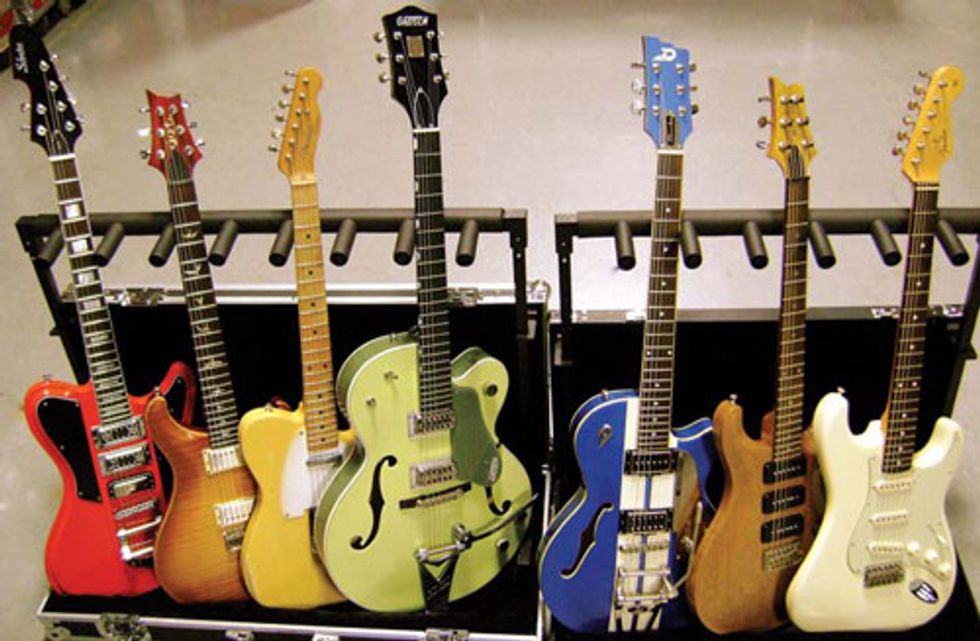One of the questions
people ask me the most is,
“Which guitars should I have
to cover the tonal bases as a
working musician?” While there
is not one universally accepted
answer, I’ll discuss some of the
guitar tones I use on a regular
basis, as well as the guitars I
select to achieve those tones.

A rich sonic palette (left to right): Schecter Robin Finck signature model, Paul Reed Smith Custom 22, Fender ’50s Road Worn Tele, Gretsch 6118T-LTV, Duesenberg Mike Campbell, Paul Reed Smith KL 380, and a Fender ’62 Hot Rod Stratocaster. Photo by Paul “TFO” Allen
In the studio and touring community, producers and bandleaders often request a “Strat sound.” One of the first things I associate with the Stratocaster is its clean, funky voice, like the rhythm guitar on Michael Jackson’s “Billy Jean.” I play a Fender ’62 Hot Rod Stratocaster and use the neck and middle pickups together through a clean amp to get that “chanky” sound. The ’62 Hot Rod Strat has a reverse-wound middle pickup, which, when you use it with the neck or bridge pickup, helps cut down on the noise that’s commonly associated with singlecoils. The other thing I really like about this particular Strat is that the fretboard is relatively flat, so I can bend the strings as far as I want. On a lot of Strats (especially those with a vintage-style fretboard radius), notes will choke after you bend the string beyond a certain point, because the string hits the peak of the fretboard’s radius curve. A great modification for any Strat is to wire one of the tone controls to the bridge pickup, which enables you to easily adjust its brightness. This feature is already included on the ’62 Hot Rod and helps keep the sound from becoming shrill and piercing.
Another great guitar for clean funk is a Telecaster. If you want a guitar that covers the most extreme end of the brightness spectrum, it’s hard to beat a Telecaster with a maple fretboard. For clean funk tones on a Tele, once again I use the neck and bridge pickup together and roll the tone knob back a bit. I usually like to make Telecasters a little more full sounding. To do that, I swap out the stock saddles for thicker saddles. This adds body to the sound without sacrificing twang.
When it comes to brightness and twang, Gretsch guitars are a great option as well. On Gretsches, I install a Tune-omatic bridge, because I prefer the bridge saddles to have a sharp edge where the string leaves the saddle. This gives the notes more definition, and I can really feel the differences in how the strings behave with a Tune-o-matic. I also pin the bridge to the top of the guitar. If the bridge isn’t pinned, it can very easily get moved when you’re playing or when you’re changing strings. If this happens, the intonation will be thrown off. Also, I prefer unbound f-holes on hollow guitars, because the guitar feels more responsive and vibrant. The 6118T-LTV is great because it already sports all my favorite features straight out of the box.
Now let’s move on to rock tones. My PRS Custom 22 is my workhorse guitar—I can use it for everything. Guitars are tools to help us do our job of playing music, and to me, PRS guitars are like a Swiss Army knife. It’s always good to have one with you to assist with anything you may encounter. My Custom 22 is loaded with 57/08 pickups, which are great for Led Zeppelin-inspired rock sounds, as well as heavier modern rock. For stripped-down, raw rock tones, I use a PRS KL 380. The KL 380’s P-90- style soapbar pickups are great for getting a Green Day-style crunch. The great thing about P-90s is that the attack will have some crunch, but the post-attack bloom will be clean, so you can clearly distinguish every string. When you double this tone in the studio, its sounds huge and can be turned up really loud in the mix. It’s nice to have one or two guitars in your arsenal that possess an individual personality. When I need a sound that falls somewhere between a Les Paul and a Gretsch, I grab my Duesenberg Mike Campbell. The P-90 and humbucker pickup configuration allows me to dial in a wide variety of tones that have their own sonic character. The Schecter Robin Finck signature model also has a diverse palette of sounds and delivers some unique tones that work great with effects for keyboard- type textures. The Finck is also a great rock guitar and can produce some very convincing single-coil tones, as well.
Do you have to own all of these guitars to be a professional musician? No. Can you play the same songs on any electric guitar? Yes—so find the right tool for the job, and get to work!






![Rig Rundown: Russian Circles’ Mike Sullivan [2025]](https://www.premierguitar.com/media-library/youtube.jpg?id=62303631&width=1245&height=700&quality=70&coordinates=0%2C0%2C0%2C0)

















